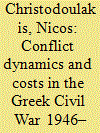|
|
|
Sort Order |
|
|
|
Items / Page
|
|
|
|
|
|
|
| Srl | Item |
| 1 |
ID:
119208


|
|
|
|
|
| Publication |
2013.
|
| Summary/Abstract |
The objectives of this paper are twofold. First, we aim to clarify the mechanism by which use of farm machinery in Chinese agriculture has grown rapidly over the past decades, using a separate Cobb-Douglas (SCD) production function. Second, we determine under what condition will China's grain self-sufficiency be secured in the next decade. Our empirical results reveal that the supply and factor demand functions based on the SCD form can significantly explain the reality, in particular, the capital demand function. This finding suggests that the recent capital deepening in Chinese agriculture is caused by farmers' behavior in response to the government's directives aimed at securing arable land. Our simulation analysis reveals that the attainment of a 95% self-sufficiency rate would be quite challenging for China, unless the terms of trade in agriculture improve substantially in favor of producers. China's policy makers must therefore seriously reconsider whether adhering to the policy goal of grain self-sufficiency is worth the effort.
|
|
|
|
|
|
|
|
|
|
|
|
|
|
|
|
| 2 |
ID:
146508


|
|
|
|
|
| Summary/Abstract |
Using a new set of data from Greek Army sources, US military archives, and Communist Party documents, the paper provides a quantitative analysis of the armed confrontation that took place in Greece during 1946–1949. A dynamic Lotka–Volterra model is estimated, pointing to the existence of a conflict trap that explains the prolongation of the civil war and its dire consequences for the country. A regional analysis finds that the mobilization of guerrilla forces was crucially affected by morphology and the local persecutions of political rivals. Using neoclassical growth-accounting, the economic cost of the conflict is estimated to surpass an annual GDP, in line with similar findings in contemporary civil wars. The same framework is employed to assess the outcome in counterfactual situations discussed in this paper.
|
|
|
|
|
|
|
|
|
|
|
|
|
|
|
|
| 3 |
ID:
159805


|
|
|
|
|
| Summary/Abstract |
The study estimates the technical efficiency (TE) of agricultural production in India using production frontier model for both cross-section and panel data for the years 1999 and 2007. Given the persistent low productivity of agriculture in India, there is a serious need to identify the determining factors for technological lock-in for agricultural production in order to accelerate sustainable productivity and technical efficiency. The model claims that farmer’s education, household’s production process, proportion of irrigated area covered by canals, availability of wells, yielding variety of lands, government services, agricultural expenditure by local government and women reservations in local government significantly contribute to efficiency in resource utilization in farm production. Traditional techniques such as ‘learning by doing’ is, generally, preferred than the adoption of new technologies for agricultural production. It makes a constraint of technological lock-in.
|
|
|
|
|
|
|
|
|
|
|
|
|
|
|
|
| 4 |
ID:
100753


|
|
|
|
|
| Publication |
2010.
|
| Summary/Abstract |
On explaining regional differences, the current literature emphasizes the difference in factor accumulations. This paper suggests an additional possibility that regions may differ in parameter values in their production functions. In terms of the Cobb-Douglas production function, regions may differ in the share of capital in income. Using the province-level data in China, this paper shows that capital shares have a very significant and positive effect on per capita GDP. In particular, the differences in production functions explain 46.6% of the difference in per capita output between the East region and West region in China. Further, using the firm-level data, we show that the differences in regional production function are likely due to different industry compositions.
|
|
|
|
|
|
|
|
|
|
|
|
|
|
|
|
| 5 |
ID:
165366


|
|
|
|
|
| Summary/Abstract |
During the last decade, Bangladesh economy grew consistently over 6 per cent annually; however, growth rate in the agriculture sector declined. Labour away from agriculture is evident; it is also evident real wages in the agriculture sector are rising. This could be an indication that Bangladesh is moving to a different stage of economic development. This article investigates whether Bangladesh is approaching a stage of economic development where marginal productivity of labour equals its price, called the Lewis turning point (LTP). We find that the reallocation of labour away from agriculture has had a positive but insignificant impact on economic growth in Bangladesh. We also find that the surplus agricultural labour has not fully been absorbed by the economy. Therefore, we conclude Bangladesh has yet to reach the LTP and suggest initiating policies (e.g., job creation in the service sector) that might speed up the country’s movement to the LTP.
|
|
|
|
|
|
|
|
|
|
|
|
|
|
|
|
|
|
|
|
|